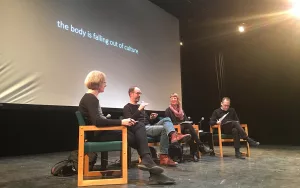Garnet Hertz’s talk delves into his personal relationship with his 3D printer, using it as a lens to explore broader themes of technological adoption. He discusses the initial excitement and promises of new technology, the eventual realization of its limitations and challenges, and advocates for a balanced approach that integrates both old and new tools in creative endeavors. Through anecdotes and reflections, Hertz offers a nuanced perspective on technology, emphasizing the importance of critical engagement and realistic expectations.
This presentation was part of the symposium Unhanded. In this panel we ask about the variety of new relationships with materials that emerging with the increasing ubiquitousness of digital technologies. With the increased complexity of tools we wonder how do we learn about materials? How do we get to know them? How do we share this knowledge? We can now know the molecular structure of wood or metal without touching it. Is this a more intimate relationship than working directly with our hands? Does it matter? If the objects coming out of digital and mechanical processes are more removed from our handywork, how might they carry the mark of the machine? Should we be able to read the machine in the material?
Garnet Hertz is Canada Research Chair in Design and Media Arts, and is Associate Professor of Design at Emily Carr University. His art and research investigates DIY culture, electronic art and critical design practices. He has exhibited in 18 countries in venues including SIGGRAPH, Ars Electronica, and DEAF and has won top international awards for his work, including the Oscar Signorini Award in robotic art, a Fulbright award, and Best Paper Award at the ACM Conference on Human Factors in Computing Systems (CHI). He has worked as Faculty at Art Center College of Design and Research Scientist at the University of California Irvine. His research is widely cited in academic publications, and popular press on his work has disseminated through 25 countries including in publications like The New York Times, Wired, The Washington Post, NPR, USA Today, NBC, CBS, TV Tokyo and CNN Headline News.
I tend to be quite nostalgic in my work
Initially when working with an old technology, let’s say this is clay or ceramic or metal or whatever foam core, you would build it with your hands. And and it’s this is sort of a representation of the old way of doing something. Then a new thing comes along. Okay. So it has a lot of promise. Okay. So this I think of as the you know, I need you so bad face like, I love you. I take my money face of like Kickstarter where it’s like you want to throw your money at at a new thing that comes along that is has a lot of promise. It has the promise that it will free you from all of your constraints and it will replace everything. It’s like when peanut butter came out, it was projected that this was going to obliterate margarine and butter, you know, or the the elevator was going to completely replace stairs. Now, of course, some of this is true, but it tends to be overstated during the beginning, especially if it’s in a Kickstarter campaign. After and this isn’t two weeks later, I thought about this after because it takes more than two weeks to get a Kickstarter product. It takes more like a year and a half, but that’s another story. So two weeks after you get this thing, the material reality of this, this new digital technology sets in how to calibrated the inconsistencies, the limitations, and this is where you are are working with this new system. This could be a scene C machine. This could be lots of different things. But 3D printing is sort of the poster child of a lot of what we’re talking about today. This is where you’re you’re still in love with the technology and you’re working with it, although you’re discovering that maybe that Kickstarter campaign had was overstating the technology somewhat. After about a month, it’s sort of like, well, I guess this only prints in like ugly colored plastic and my printer keeps jamming and after printed a bunch of heads and keychains, whatever things a 3D modeling is actually quite hard. Right? The the there’s an aspect of the new technology that has a lot of promise, but there’s a lot of fine print. You’re just you have problems. You’re posting on discussion groups about how to fix it. You realize that open source hardware is actually a lot of times just kind of an unfinished piece of hardware that doesn’t really work very well. It doesn’t have good documentation, not all the time, but sometimes. And then six months later you are this this is in my case, maybe some people go faster or slower through this process. So it’s sort of coming to an understanding that that you’re in a become into a settled relationship with this thing or it’s like, okay, yes, this this technology is is great. It it has a it has a really useful place in a lot of what I’m going to do, but I’m not going to immediately drop all of my tools for making models out of foam core. I’m not going to stop welding or using a drill press. You know, this is this is something that’s really useful. So you sort of get into this domestic relationship with this with this device and you print the odd Pikachu head or whatever off of it for your kids or whatever. And then for me at least, I with new technologies, I mean, I tend to be quite nostalgic in my work.

An engaging panel with Kristin Anne Carlson, Davide Rokeby and Chris Salter, moderated by Nell Tenhaff which delves into different relationships artists are cultivating with machines.